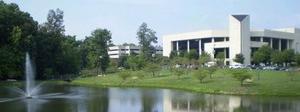BioterrorismGeorge Mason University opens $50 million biomedical lab to fight bioterrorism
George Mason University has opened a $50 million biomedical research laboratory as part of the U.S. effort to fight bioterrorism; research will focus on the diagnosis, prevention and treatment of infectious diseases and on pathogens the government thinks could be used in a bioterrorism attack

The Pond at George Mason University // Source: gmu.edu
George Mason University recently opened a biomedical research laboratory in Prince William County where scientists and researchers will study infectious diseases and be part of the national effort to fight bioterrorism. The $50 million lab is across from the university’s Prince William campus and is one of 13 biocontainment laboratories in the nation that were built with the help of grants from the National Institute of Allergy and Infectious Diseases.
“This is groundbreaking work we will be doing,” said Charles Bailey, the lab’s director. “We feel certain that our BRL-based research will lead to medical breakthroughs that will ultimately help protect the nation from bioterrorism and outbreaks of infectious disease.”
The Washington Post’s Jennifer Buske writes that about fifty people will be working at the 52,000-square-foot facility, which also received funding from the university and the state.
Research will focus on the diagnosis, prevention and treatment of infectious diseases and on pathogens the government thinks could be used in a bioterrorism attack. Some of the diseases studied will be anthrax, plague, influenza and Rift Valley fever, a viral disease found in parts of Africa that is often transmitted by mosquitoes and can infect domestic animals and humans.
“If this were to show up here, it would make West Nile look like child’s play,” said Bailey, noting the labs won’t open for another few months because government agencies still need to certify the facility and ensure it is safe to operate.
Research on the Rift Valley fever, along other pathogens, will be conducted in a highly secure lab space in a building within the overall facility. Although university students will have access to some of the 20,000 square feet of lab space in the facility, the secure labs will be used only by people who have passed a federal background check.
Buske quotes university officials to say that, because of the work being done in the facility, stringent federal safety guidelines had to be followed. Blastproof windows and walls surround the facility, and cameras and security officials monitor the building at all times. The building was also designed to suck all air into the center of the facility, so it can go up through two filters before exiting into the city. “The air we borrow from Manassas is returned cleaner than when we took it in,” Bailey said.
Because of the extra safety measures taken in the construction of the facility, university officials said, the possibility of the release of a biological agent from the lab into the community is extremely low.
University officials said the new facility will complement GMU’s National Center for Biodefense and Infectious Diseases, also on the Prince William campus, and serve as an economic engine in the community by attracting biotechnology companies.
The new secure labs will also help the university leverage additional federal research funding and attract top scientists, officials said. Bailey said that seven out-of-state companies have contacted him about conducting research at the labs.
